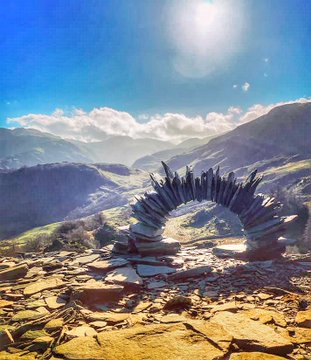- Joined
- Aug 7, 2001
- Messages
- 54,631
This is fascinating:
Stone me! Meet the man who's made balancing giant rocks an artform
By Vince Graff
Last updated at 8:04 AM on 15th September 2010

A dazzlingly clear morning and I am standing on a rock-strewn, deserted beach in Dorset. Behind me, in this beautiful bay, a lush cliff face sprouts 1,000 different shades of green. Bliss you might think. And it is. Except that my fingers are sore, my arms are aching and (I am sorry to say this) I almost wish I were back in the office in London.
The reason? For two hours I've been desperately trying to balance giant rocks on top of each other. And failing badly.
Perhaps I should explain. I am here to meet Adrian Gray - one of Britain's oddest artists. And this amazing beach, accessible only by boat or a treacherous climb, is Gray's canvas.
Gray, you see, has an unusual artistic technique. Remember that famous Monty Python sketch about The Society For Putting Things On Top Of Other Things? The joke was about how human beings can unwittingly immerse themselves in utterly futile activities.
Well, the art Gray creates is a result of nothing more sophisticated than putting things on top of other things. Big rocks on top of other big rocks, to be precise.
Then he photographs the results and sells the images. How futile can you get?
But the weird thing is that it's not futile at all. The end results are, quite simply, breathtaking.
Look at the images here. Surely these rocks - virtually floating on air - cannot possibly stay standing? Just what is holding them in place? Has the Government secretly repealed the laws of physics?
Yet there is no cheating involved in any of the photographs. No steel rods, no magnets, no computer trickery. The only glue he uses is Nature's. Gravity.
By very carefully 'feeling' the balancing point of each rock he handles - a process that requires awesome skill and patience - Gray is able to arrange them in ways that seem incredible.
Imagine trying to balance a chest of drawers on just one of its legs, on top of a boulder, and you get an idea of what Gray gets up to.
'There is a real sense of wonder,' says Gray, 'when I balance two rocks in such a way that it gives the impression that it's impossible for them to stay in place. I don't want to sound pretentious, but it makes the sculpture seem almost alive.'
Do people think he cheats? All the time.
'People think I use everything from Blu Tack to Velcro to steel rods. While I'm balancing the stones, I can hear people saying: "He's waiting for the glue to set."' 8)
Having witnessed Gray's magic, I can confirm there is no trickery involved. Only patience, dexterity and what Gray calls 'listening with my fingers'.
etc...
Read more: http://www.dailymail.co.uk/news/article ... z0zafgVqfJ
https://www.stonebalancing.com
Stone me! Meet the man who's made balancing giant rocks an artform
By Vince Graff
Last updated at 8:04 AM on 15th September 2010
A dazzlingly clear morning and I am standing on a rock-strewn, deserted beach in Dorset. Behind me, in this beautiful bay, a lush cliff face sprouts 1,000 different shades of green. Bliss you might think. And it is. Except that my fingers are sore, my arms are aching and (I am sorry to say this) I almost wish I were back in the office in London.
The reason? For two hours I've been desperately trying to balance giant rocks on top of each other. And failing badly.
Perhaps I should explain. I am here to meet Adrian Gray - one of Britain's oddest artists. And this amazing beach, accessible only by boat or a treacherous climb, is Gray's canvas.
Gray, you see, has an unusual artistic technique. Remember that famous Monty Python sketch about The Society For Putting Things On Top Of Other Things? The joke was about how human beings can unwittingly immerse themselves in utterly futile activities.
Well, the art Gray creates is a result of nothing more sophisticated than putting things on top of other things. Big rocks on top of other big rocks, to be precise.
Then he photographs the results and sells the images. How futile can you get?
But the weird thing is that it's not futile at all. The end results are, quite simply, breathtaking.
Look at the images here. Surely these rocks - virtually floating on air - cannot possibly stay standing? Just what is holding them in place? Has the Government secretly repealed the laws of physics?
Yet there is no cheating involved in any of the photographs. No steel rods, no magnets, no computer trickery. The only glue he uses is Nature's. Gravity.
By very carefully 'feeling' the balancing point of each rock he handles - a process that requires awesome skill and patience - Gray is able to arrange them in ways that seem incredible.
Imagine trying to balance a chest of drawers on just one of its legs, on top of a boulder, and you get an idea of what Gray gets up to.
'There is a real sense of wonder,' says Gray, 'when I balance two rocks in such a way that it gives the impression that it's impossible for them to stay in place. I don't want to sound pretentious, but it makes the sculpture seem almost alive.'
Do people think he cheats? All the time.
'People think I use everything from Blu Tack to Velcro to steel rods. While I'm balancing the stones, I can hear people saying: "He's waiting for the glue to set."' 8)
Having witnessed Gray's magic, I can confirm there is no trickery involved. Only patience, dexterity and what Gray calls 'listening with my fingers'.
etc...
Read more: http://www.dailymail.co.uk/news/article ... z0zafgVqfJ
https://www.stonebalancing.com
Last edited by a moderator:



